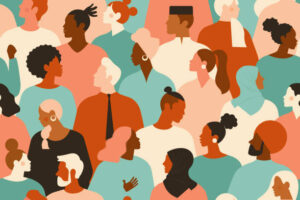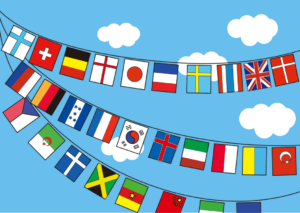
Communities are the foundation of society. They foster a sense of belonging and identity within a group of people who share a purpose. The way people perceive the “others” in comparison to themselves, greatly affects the way they choose to interact with them. All of the communities I have been a part of have had sub-communities within them that arise from more specific characteristics which lie outside of the shared purpose of the larger community. For example, at Dickinson, all of the students are part of the community because we are enrolled at Dickinson with the purpose of getting a college education. However, some people play sports, while other play instruments. Some people are a part of the Biology department, while others are belong to the Political Science department. The “others” in each situation vary depending on who you ask, and perspective is crucial.
The Dickinson community is fairly diverse, with many people coming from different backgrounds. The “others” within a community share certain characteristics beyond their control that may set them apart from the larger community. For example, ethnicity, race, nationality, etc. are all characteristics that automatically unite people into groups. If the characteristic they share is the minority within that community, they may be perceived as the “others.” For instance, Dickinson has a small population of international students who all share a different cultural background than the majority of students of attend Dickinson. In some sense they are a collective “other” in the community, even if they are not all from the same country, they are still a part of the international community.

It is important to note that when groups of people are classified as “others” it strips them of their individuality. Unfortunately this can also lead to discrimination against these groups for being considered different than other sub-communities that are the majority. Although this may not always be the case, it has been seen throughout history as a common theme. It can be difficult to for groups that are primarily perceived as plural, rather than separate individuals, to integrate fully into the community. For example, my grandparents immigrated to the United States from Myanmar, and have always said they felt like outsiders wherever they lived. While they may have been a part of the community they lived in, they were considered “others” because of their accents and physical features.

This dynamic can also be seen within the international system which can cause unnecessary damage to individuals who live in countries that are considered “others.” The international system is one big community, and there are smaller sub communities within the system. Nationalism plays a large role in how other countries perceive each other. Countries that share similar cultures and social norms group together, and view other groups in the international system as “others.” It is natural for groups of people to interact with others who share similar cultures and social norms.
However, problems arise when individuals or countries actively exclude or discriminate against the “others” purely because they are on the outset of their community. It is crucial, in both local and international communities, to recognize that the “others” in our communities are other groups of people. To perceive someone purely based on comparative differences between our respective communities is unfair. Recognizing individuality beyond the percieved otherness is a much more productive way of living.
Comments
Hi Maya! Your commentary about who is considered an “other” is from one’s perspective is very interesting. In my post, I talked about more of a collective view, where several individuals within a community have decided who is the other based on their similar views. It is really easy to forget that each person is part of several communities and that each of those communities influences one’s beliefs and cultural/societal views. So, I do agree with you that the other is based on perspective and due to the several communities, each person acts differently than others.
This is a very well done post that gives great analysis and examples on what life is like for people considered outsiders, and seeing and expiring groups one may perceive as outsiders. I thought that your analysis of the Dickinson community in how there’s so many different subgroups within the school, from departments to international students, yet you shared the important of still recognizing every person as they individually are. Your sharing of the experience your grandparents had as immigrants was very eye opening in that is shows how peoples of all ages, no matter how long you’ve belonged to a group or not, you can still very much feel like an outsider within that community. Your explanation of “outsiders” within the realm of International Politics was also very well written, as it explained the importance of realizing that even the people that we see or experience as “a group”, is still a group of people and nobody should be treated one way or another because they are apart of a group that’s not within the main realm of a state, or a community. As when individuality is stripped away, and states start treating communities different, conflicts can arise. Overall, this is a very well written analysis and post overall!
Your perspective on how communities form sub-groups based on shared characteristics, which can sometimes lead to the classification of certain individuals as ‘others’ is thought-provoking. You rightly highlight the importance of perspective in determining who the ‘others’ are within a community. Characteristics like ethnicity, race, and nationality can unite individuals into distinct sub-communities, and when these characteristics represent a minority within the larger community, it can lead to the perception of them as ‘others’. Your observation that classifying people as ‘others’ can strip them of their individuality and sometimes lead to discrimination is unfortunately a recurring theme in history. Your grandparents’ experiences as immigrants in the US, where they felt like outsiders due to their accents and physical features, serves as a touching example. What steps or strategies do you think can be taken within communities, such as Dickinson, AUS, or in the international context, to foster a greater appreciation for individual qualities and promote a more inclusive and fair approach, moving beyond the classification of ‘others’? Thank you for sharing this post!
Greetings, Maya
I want to start by thanking you for sharing your profound thoughts on the idea of “others” in communities. I could relate to what you said about how people view “others” and how smaller groups may have an impact on bigger ones.
I can understand the challenges of feeling like the “other” within different cultures as a kid of a third culture living in the United Arab Emirates. I frequently find myself crossing several cultural worlds because the UAE is a multicultural country with a sizable expat community. The significance of ethnicity, nationality, and culture in determining our identities within communities has been brought to light by this experience.
You made a point about how crucial it is to value uniqueness above apparent differences, and I couldn’t agree more. Communities may become more inclusive and peaceful by valuing each person’s particular traits and contributions, no matter what their background.
Using your thoughts as a foundation, I’d like to investigate how language shapes how people perceive “others.” As you said with your grandparents, I’ve found that language challenges may make people feel more isolated. What impact does language have on how people in communities, both locally and globally, see “others”?
Thank you for your thought-provoking essay, and I look forward to your response.
Warm regards,
Rakshan W. Badshah